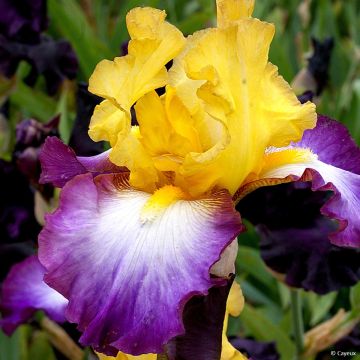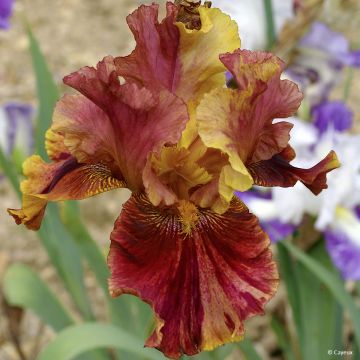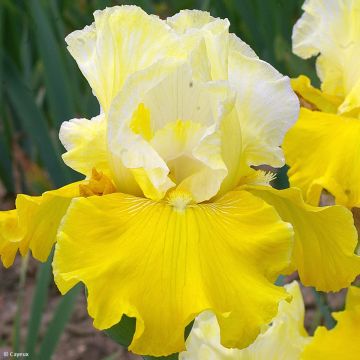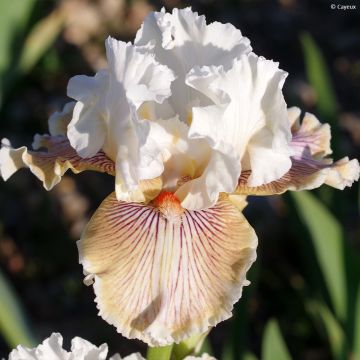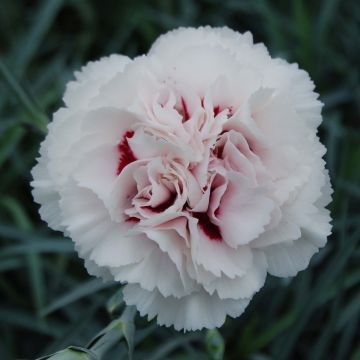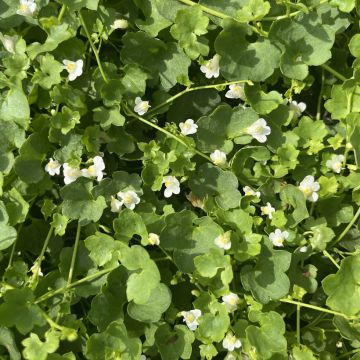

Iris germanica Brindled Beauty - Bearded Iris
Iris germanica Brindled Beauty - Bearded Iris
Iris germanica Brindled Beauty
German Iris, Bearded Iris
Special offer!
Receive a €20 voucher for any order over €90 (excluding delivery costs, credit notes, and plastic-free options)!
1- Add your favorite plants to your cart.
2- Once you have reached €90, confirm your order (you can even choose the delivery date!).
3- As soon as your order is shipped, you will receive an email containing your voucher code, valid for 3 months (90 days).
Your voucher is unique and can only be used once, for any order with a minimum value of €20, excluding delivery costs.
Can be combined with other current offers, non-divisible and non-refundable.
Home or relay delivery (depending on size and destination)
Schedule delivery date,
and select date in basket
This plant carries a 12 months recovery warranty
More information
We guarantee the quality of our plants for a full growing cycle, and will replace at our expense any plant that fails to recover under normal climatic and planting conditions.
Would this plant suit my garden?
Set up your Plantfit profile →
Description
The Iris germanica 'Brindled Beauty' is a variety of garden Iris that stands out for its resistance, generous flowering, and unusually vibrant color flowers. The petals have a delicately speckled white hue with more pronounced violet streaks on the white sepals. The beards add a bright touch to the heart of the sepals with their pretty reddish-orange tone. 'Brindled Beauty' quickly develops magnificent clumps that bloom in spring, offering several weeks of splendor to borders, rock gardens, and flower beds. This mid to late season variety extends the flowering period of an iris garden.
The Iris germanica is a perennial rhizomatous and deciduous plant that forms upright, vigorous clumps. It belongs to the family Iridaceae, which also includes plants such as Crocus, Gladiolus, and Crocosmia. The Iris germanica, also known as the bearded Iris or German Iris, is a species probably resulting from the hybridization of different botanical species. As a member of the bearded Iris group, recognizable by the fine crest on the sepals, it is one of the most cultivated iris in gardens. These plants prefer neutral to alkaline soils and require a sunny exposure to thrive. The rhizomes need to capture the heat of the sun during summer to ensure optimal flowering. Traditionally, a minimum of six hours of sunlight per day is required for their development.
The variety 'Brindled Beauty' was obtained by Allan Ensminger in 1993. Derived from the crossbreeding of 'Peach Jam' and 'Maria Tormena', this excellent variety was awarded by the American Iris Society (AIS) in 1996 and 1999. It produces stems that reach a height of 80 to 90 cm (32 to 35in) when flowering. It has strong floral stems that develop from the rhizomes, with well-built spikes carrying numerous flower buds. The clumps spread rapidly, without theoretical limits, as the central rhizomes become bare in favor of the outer rhizomes. The leaves are long and sword-shaped, with a pronounced glaucous green color and strong veins. In April, the floral stems begin to appear, and in May, depending on the climate, they produce large flowers measuring 12 to 14 cm (5 to 6in) that bloom from the top to the lower branches until the end of June. The vibrant colors of this plant are enhanced by the silky and iridescent texture of the petals and sepals, as is generally the case with garden Iris. Additionally, this variety emits a soft and delightful fragrance.
Iris easily complements other plants, whether perennials, grasses, or bushes. To accompany irises effectively, it is important to select plants based on their specific requirements such as sun exposure and soil types, ensure their growth does not smother the iris rhizomes by opting for low-growing plants with light foliage, and consider their visual aspect and flowering period complementarity. Furthermore, it is essential to remember that clumps need to be divided every 3 or 4 years, which implies reserving them adequate, non-competitive space, preferably in well-drained and not too compact soil. To create attractive flower beds throughout the growing season, it is recommended to associate irises with long-flowering perennials that tolerate dry soils, such as gauras, sages, or perennial geraniums. Columbines and California Poppies (Eschscholzia) bring lightness, while clematis create an appealing background. For added verticality, foxgloves are suitable. It is also important not to overlook foliage plants such as grasses, silver wormwoods (Artemisia), or euphorbias. Dense planting of vigorous old varieties allows for the stabilization of a slope, thus limiting maintenance. At the base of a very sunny wall, sheltered from the wind, tall irises can be planted in the background, while shorter and early varieties can be used in the foreground. A few clumps of irises can also bring cheerfulness to the vegetable garden, and their beautiful flowering stems can be used to create bouquets.
Flowering
Foliage
Plant habit
Botanical data
Iris
germanica
Brindled Beauty
Iridaceae
German Iris, Bearded Iris
Cultivar or hybrid
Other German Iris - Bearded Iris
View all →Planting and care
Do you have a very sunny location, rather dry in the summer?
This is the ideal location for planting irises! In the shade, they grow, but do not flower. They are cultivated in France in all regions. Hardy, they do not need winter protection. Well-drained soil is perfect, even if it is rather dry and chalky, or even stony. Soil that is too wet promotes rotting of the rootstock. Plant from July to September. The rootstocks have enough time to grow sufficiently before being lifted, and then to develop new roots before winter. They should be planted immediately after purchase for best results. Plan to divide irises every 4 years or so to give them fresh soil. They have strong growth and require space to develop and flower well. They are planted with spacing adapted to the size and vigour of the variety: approximately 35 to 50 cm (14 to 20in) for tall varieties (5 to 10 plants per square metre). Always take into account the direction of growth of the rootstocks by arranging them in a star shape, with buds and leaves turned outwards, and spacing them well from other varieties so they have room to grow.
Planting:
Dig a hole that is wide and deep enough. Create a conical mound of soil in the hole, on which the rootstock and spreading roots are placed. Cover the roots. It is important that the rootstock is level with the surface of the soil. It should not be planted in a hollow (risk of rotting). Consider that the soil will settle and the iris will sink. In clay or damp soil, the rootstock will even be raised on a slight mound of a few centimetres. To make the soil adhere to the roots, lightly tamp the soil and water abundantly immediately after planting. Water 2-3 times if necessary until the plant establishes.
Maintenance:
Keep the soil weed-free by shallow hoeing, taking care not to damage the rootstocks or roots. Weeds shade the irises, retain moisture (causing rot) and attract slugs. Similarly, cut off dry leaves. If they are diseased (reddish-bordered spots of heterosporiosis), we recommend burning them. Remove faded flowers.
Planting period
Intended location
Care
Planting & care advice
This item has not been reviewed yet - be the first to leave a review about it.
Similar products
Haven't found what you were looking for?
Hardiness is the lowest winter temperature a plant can endure without suffering serious damage or even dying. However, hardiness is affected by location (a sheltered area, such as a patio), protection (winter cover) and soil type (hardiness is improved by well-drained soil).

Photo Sharing Terms & Conditions
In order to encourage gardeners to interact and share their experiences, Promesse de fleurs offers various media enabling content to be uploaded onto its Site - in particular via the ‘Photo sharing’ module.
The User agrees to refrain from:
- Posting any content that is illegal, prejudicial, insulting, racist, inciteful to hatred, revisionist, contrary to public decency, that infringes on privacy or on the privacy rights of third parties, in particular the publicity rights of persons and goods, intellectual property rights, or the right to privacy.
- Submitting content on behalf of a third party;
- Impersonate the identity of a third party and/or publish any personal information about a third party;
In general, the User undertakes to refrain from any unethical behaviour.
All Content (in particular text, comments, files, images, photos, videos, creative works, etc.), which may be subject to property or intellectual property rights, image or other private rights, shall remain the property of the User, subject to the limited rights granted by the terms of the licence granted by Promesse de fleurs as stated below. Users are at liberty to publish or not to publish such Content on the Site, notably via the ‘Photo Sharing’ facility, and accept that this Content shall be made public and freely accessible, notably on the Internet.
Users further acknowledge, undertake to have ,and guarantee that they hold all necessary rights and permissions to publish such material on the Site, in particular with regard to the legislation in force pertaining to any privacy, property, intellectual property, image, or contractual rights, or rights of any other nature. By publishing such Content on the Site, Users acknowledge accepting full liability as publishers of the Content within the meaning of the law, and grant Promesse de fleurs, free of charge, an inclusive, worldwide licence for the said Content for the entire duration of its publication, including all reproduction, representation, up/downloading, displaying, performing, transmission, and storage rights.
Users also grant permission for their name to be linked to the Content and accept that this link may not always be made available.
By engaging in posting material, Users consent to their Content becoming automatically accessible on the Internet, in particular on other sites and/or blogs and/or web pages of the Promesse de fleurs site, including in particular social pages and the Promesse de fleurs catalogue.
Users may secure the removal of entrusted content free of charge by issuing a simple request via our contact form.
The flowering period indicated on our website applies to countries and regions located in USDA zone 8 (France, the United Kingdom, Ireland, the Netherlands, etc.)
It will vary according to where you live:
- In zones 9 to 10 (Italy, Spain, Greece, etc.), flowering will occur about 2 to 4 weeks earlier.
- In zones 6 to 7 (Germany, Poland, Slovenia, and lower mountainous regions), flowering will be delayed by 2 to 3 weeks.
- In zone 5 (Central Europe, Scandinavia), blooming will be delayed by 3 to 5 weeks.
In temperate climates, pruning of spring-flowering shrubs (forsythia, spireas, etc.) should be done just after flowering.
Pruning of summer-flowering shrubs (Indian Lilac, Perovskia, etc.) can be done in winter or spring.
In cold regions as well as with frost-sensitive plants, avoid pruning too early when severe frosts may still occur.
The planting period indicated on our website applies to countries and regions located in USDA zone 8 (France, United Kingdom, Ireland, Netherlands).
It will vary according to where you live:
- In Mediterranean zones (Marseille, Madrid, Milan, etc.), autumn and winter are the best planting periods.
- In continental zones (Strasbourg, Munich, Vienna, etc.), delay planting by 2 to 3 weeks in spring and bring it forward by 2 to 4 weeks in autumn.
- In mountainous regions (the Alps, Pyrenees, Carpathians, etc.), it is best to plant in late spring (May-June) or late summer (August-September).
The harvesting period indicated on our website applies to countries and regions in USDA zone 8 (France, England, Ireland, the Netherlands).
In colder areas (Scandinavia, Poland, Austria...) fruit and vegetable harvests are likely to be delayed by 3-4 weeks.
In warmer areas (Italy, Spain, Greece, etc.), harvesting will probably take place earlier, depending on weather conditions.
The sowing periods indicated on our website apply to countries and regions within USDA Zone 8 (France, UK, Ireland, Netherlands).
In colder areas (Scandinavia, Poland, Austria...), delay any outdoor sowing by 3-4 weeks, or sow under glass.
In warmer climes (Italy, Spain, Greece, etc.), bring outdoor sowing forward by a few weeks.
































